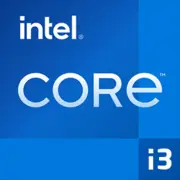Intel Core i3-7100

Intel Core i3-7100: Budget Processor for Basic Tasks in 2025
Architecture, Performance, and Relevance in Modern Conditions
Key Specifications: Kaby Lake in Detail
The Intel Core i3-7100 processor, released in 2017, belongs to the 7th generation of Kaby Lake architecture. Being the last Intel line on a 14nm manufacturing process before transitioning to 10nm, it is considered outdated in 2025, yet still suitable for limited scenarios.
Key Parameters:
- Cores and Threads: 2 cores, 4 threads (Hyper-Threading).
- Base Clock Speed: 3.9 GHz (without Turbo Boost).
- Cache: 3 MB L3.
- TDP: 51 W.
- Integrated Graphics: Intel HD 630 (basic support for 4K@60Hz via HDMI 1.4).
Main Features:
- Support for AVX2 and SSE4.2 instructions for accelerating media tasks.
- Optane Memory technology (for HDD acceleration).
- Lack of support for PCIe 3.0 x16 (relevant for entry-level discrete GPUs).
Performance:
According to Geekbench 6 (2025), the i3-7100 demonstrates:
- 1231 points (single-thread test) — a level close to modern budget processors like the Intel Pentium Gold G7400.
- 2407 points (multi-thread) — its weak point due to only 2 cores.
Compatible Motherboards: What to Choose in 2025?
The processor uses the LGA 1151 (v2) socket, compatible only with the 200 series chipsets:
- B250/H270: an optimal choice for basic builds.
- Z270: for enthusiasts, though overclocking with the i3-7100 is not possible.
Examples of Models:
- ASUS Prime B250M-A (price for leftovers — $50–70).
- Gigabyte H270-HD3 (found in the secondary market).
Important:
- Motherboards for Kaby Lake do not support 8th generation processors (Coffee Lake).
- A BIOS update is required for installation on some boards (relevant when purchasing used).
Memory Support: DDR4 and Its Limitations
The i3-7100 works only with DDR4-2133/2400 MHz (officially). The maximum capacity is 64 GB, but real builds rarely use more than 16–32 GB.
Recommendations:
- Use dual-channel mode (2×8 GB instead of 1×16 GB) for a 15–20% performance boost in gaming and rendering.
- DDR5 and higher frequencies are not supported — this is a key limitation for upgrades.
Power Supply: Minimum Requirements
With a TDP of 51 W, the processor is not demanding on the power supply:
- Without a discrete graphics card: a 300–400 W PSU is sufficient (e.g., be quiet! System Power 10 400W, $45).
- With a GPU like NVIDIA GTX 1650: choose a 500 W PSU with 80+ Bronze certification (Corsair CX550M, $65).
Tip: Don’t skimp on the PSU for stability — cheap models may not provide stable voltage.
Pros and Cons of the i3-7100 in 2025
Advantages:
- Low price on the secondary market ($30–50).
- Energy efficiency (suitable for compact PCs).
- Integrated graphics for office tasks and 4K video.
Disadvantages:
- Only 2 cores — multitasking is limited.
- No support for PCIe 4.0, DDR5, USB 3.2 Gen 2.
- Lags behind even budget processors from 2025 (e.g., AMD Ryzen 3 7300U) in multi-threading.
Usage Scenarios: Where is the i3-7100 Relevant?
1. Office PCs: Working with documents, browsing, Zoom.
2. Media Centers: Playing 4K content via HDMI (with HDR limitations).
3. Light Gaming: Dota 2, CS2 on low settings (30–40 FPS in Full HD with a GTX 1050 Ti-level GPU).
4. Home Servers: NAS based on Linux (due to low TDP).
Limitations:
- Video editing in DaVinci Resolve or Blender will be agonizingly slow.
- Modern open-world games (Cyberpunk 2077, Starfield) are not recommended.
Comparison with Competitors
1. AMD Ryzen 3 1200 (2017):
- 4 cores/4 threads, but weaker in single-threaded tasks (Geekbench 6 Single Core: ~950).
- Price on the secondary market: $25–40.
2. Intel Core i3-10100 (2020):
- 4 cores/8 threads, Geekbench 6 Multi Core: ~4800.
- 30–50% faster, but costs $80–100 (used).
Conclusion: In 2025, the i3-7100 falls behind even budget newcomers but is cheap for basic tasks.
Practical Assembly Tips
1. Motherboard: Look for B250/H270 with warranty or test used ones.
2. Cooling: The stock cooler is sufficient — noise is minimal.
3. Storage: Always use an SSD (e.g., Kingston A400 240 GB, $25) to speed up the system.
4. Case: Micro-ATX (Fractal Design Core 1100) for compactness.
Caution: Do not buy new components for this processor — it’s an investment in an outdated platform.
Final Conclusion: Who Should Consider the i3-7100?
This processor should be considered only in cases where:
- Building the cheapest possible PC for office use or web browsing.
- Upgrading an old computer without replacing the motherboard.
- Creating a media center on a minimal budget.
Alternative: For $100–150, you can buy a used Intel Core i5-9400F or AMD Ryzen 5 2600, which are significantly more powerful.
In 2025, the i3-7100 is a choice for those who value saving money and do not require performance. For everyone else, the market offers much more interesting options.
Basic
CPU Specifications
Memory Specifications
GPU Specifications
Miscellaneous
Benchmarks
Compared to Other CPU
Share in social media
Or Link To Us
<a href="https://cputronic.com/index.php/cpu/intel-core-i3-7100" target="_blank">Intel Core i3-7100</a>